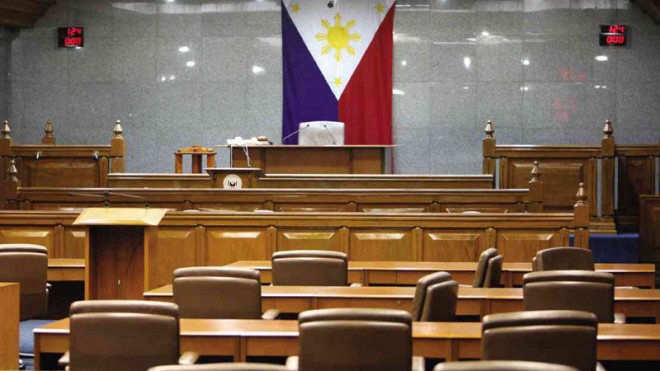Senate stands on dangerous ground
In an earthquake, the Senate building could be swallowed up by a sinkhole opened up by soil liquefaction.
Or it could be swept away in a seiche caused by the earthquake, as it actually sits on Manila Bay.
But that’s probably a too far-off scenario that no senator was in the building during Thursday’s earthquake drill.
Senate employees and guests, however, gamely followed instructions as drill leaders guided them to “safety” during the exercise.
During the drill, the Senate worked under the presumption of soil liquefaction, as the building sits on land reclaimed from Manila Bay.
Article continues after this advertisementShaking caused by an earthquake could make soil lose substantial strength and stiffness, making it behave like liquid.
Article continues after this advertisementIn some cases, the ground caves in, sucking buildings into the resulting sinkhole. In other cases, the soil turns too soft to hold up buildings, which topple over.
At 10:30 a.m., the alarm sounded and the lights went out.
Employees were guided through the dark hallways by security personnel with flashlights and directed on the way out of the building.
On Wednesday, the employees were advised to go to the sixth and seventh floor, the designated evacuation area.
But Senate sergeant at arms Jose Balajadia said the plan was changed early Thursday on the advice of an expert, who told Senate officials that the building could tilt in case of soil liquefaction.
Going to the top of the building, however, could save lives, too, because in a seiche, Balajadia said, there’s no way the employees could outrun incoming waves.
Seiche is the oscillation of the water in a bay or lake caused by an earthquake, something like a tsunami in an enclosed body of water.
Once an earthquake strikes, the protocol is for the employees to drop what they are doing and protect themselves by ducking under tables and staying away from windows, Balajadia said.
The building’s windows are large and covered with glass, which could be shattered in an earthquake, sending shards flying all around and injuring people.
After 45 seconds, rescue operations would begin, Balajadia said.
But in an emergency, he said, everyone would have to take care of themselves.
Senate Secretary Oscar Yabes said he would suggest that another earthquake drill be held with the participation of the senators.
After the drill, Sen. Loren Legarda issued a statement, saying fire and earthquake drills, as well as other disaster preparedness measures, should be conducted monthly in educational and health-care institutions.
Such drills would help citizens remember disaster preparedness measures better, Legarda said.
Legarda has introduced legislation that would require schools, hospitals, nursing homes, orphanages and other establishments that care for the disabled and other vulnerable people to conduct emergency drills regularly.
Her bill would also require instructions on the use of emergency exits, fire extinguishers and other related features and equipment, and training staff on the evacuation of buildings.
